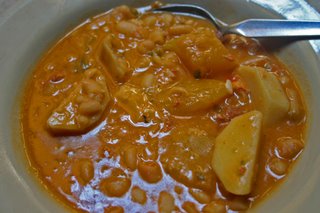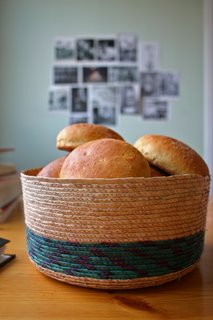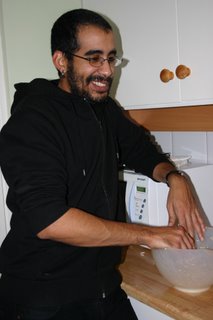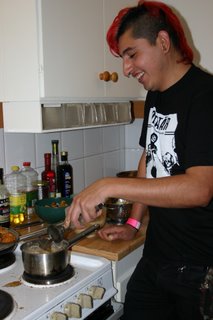
I made this dish in Cuba - a country where a meal without rice and beans hardly is considered a meal at all - on a housewife-y Sunday specked with laundry (hand-washed!) and cleaning. It certainly revitalised why poor self after such a "hell-on-earth" experience. The white beans are not as popular in Havana as black or kidney beans but the Cuban friend I shared house with at the time loved the stew. The rich, a little hot and smoke-y flavour given by the chorizo contrast nicely with the mild neutral flavours of the beans and caladium and the sweetness of the pumpkin.
My plan was to make this stew with some beautiful black eyed beans I found in a farmers market. I bought 1lb (about 500g) and planned to use half of it on making this stew and the other half on a cold salad with raw onions, sweet pepper and vinegar. But things don't always turn out as one plans. Specially not in Cuba where the only thing one is said to be able to count on is the need to improvise. Planning is loosing one's time since reality there (for various reasons) seems to be particularly hard to predict. So: when I opened the little plastic bag the beans were full of grubs. There wasn't a bean without a tiny and absolutely circular hole in it and the little insects responsible for the holes jumped all over. I had to throw away everything and go buy white beans instead since black eyed beans are very rare in Havana. But - and this is also held as a general truth in the largest of the Antilles - tings turned out well in the end anyways! I suppose I'll make the same stew with black eyed beans some other day.
As always with stews they are even tastier a few hours after being made (am I the only person who prefer my food luke-warm?) or reheated the day after. Perfect to make on a Sunday when you have lots of time and then take with you in the lunch-box on Monday!
Eat it with rice and a nice salad. I particularly like the combination of chorizo with avocado so - if I had had some ripe avocados at home when I made it - i would have had a salad with avocados. And if I hadn't been so hungry after all the laundry and cleaning I might have had time to make some tostones too. As it was I and my friend just ate it with white rice...
---
Judias con chorizo - Stew on white beans and Chorizo
(serves approx. 4 persons)
1/2lb (250g) white beans
1 big onion
4-5 garlic cloves
1 red sweet pepper
2 medium sized caladiums (or potatoes)
1/2 small pumpkin
1 1/2 small chorizo (the sort that is supposed to be cooked)
1 1/2 dl of wine or sherry
1 tbsp tomato paste
cumin
salt
sugar
Cook the beans until soft.
When the beans are almost ready it's time to prepare the rest of the ingredients:
Chop garlic, onions and pepper and fry a couple of minutes in oil. '
Peel and cut the caladium (or potatoes) and the pumpkin in big chunks (if the peaces are too small they will disintegrate when cooked).
Peel the chorizo (ordinarily they come with a "skin" that has to be removed) and cut in small cubes.
Add all the ingredients when the beans are soft and season with wine, tomato paste, cumin, salt and sugar.
Remember that the chorizo can be rather salty so be careful with the salt.
Ok, so, now comes the most difficult step. As in all Cuban bean stews it has to "cuajar"* which basically means it has to boil gently (without pressure but under a lid if you used a pressure cooker to soften the beans) until it has become thick and creamy and all the tastes have come fourth. If you have ever eaten a stew that has "cuajado" you will never want to eat a "watery" stew ever again! I let myself be guided by the sound of the boiling, the feeling of the stew as I stir it and the taste of the sauce. It's better to let it cook a few minutes too much than to end up with a watery, tasteless thing. In other words: don't panic about reducing the cooking time to preserve vitamins. That's not the priority here! Just be patient in a laid-back Caribbean way and everything will turn out just nice!
---
Specific notes on this stew:
I do NOT recommend you to skip the sugar! In my taste (and I'm not especially fond of sugar) white beans, just like black beans and black eyed beans, need a little sugar as it brings fourth their wonderful taste.
If you are vegetarian/vegan I guess you can exclude the chorizo but since the smoke-y flavour is the fun part of this dish you may want to substitute the chorizo with something vegetarian with a smoked flavour: sesame-oil? heavily roasted nuts? some smoked cheese crumbled over the served stew? Once I burnt my beans (making a totally different dish) and the result was a smoked taste...kind of... Anyway: be creative but don't just exclude the chorizo, replace it! (And please mail a post about the result here!)
---
General notes on Cuban bean stews:
Every country seems to have its own customs when it comes to boiling beans. In some countries one let the beans soak in water a couple of hours and then put them on the stove. In other countries (as in Cuba) one skip the soaking completely. Some use a regular pot while others use a pressure cooker. Some (like my parents) even put a regular pot with beans and water in the oven and let it boil slowly during the night. Choose your regular way and use a large pot, lots of water and NO SALT! The salt prolongs the time it takes for beans to soften.
Garlic and onion (and sometimes sweet pepper) fried in oil is called "sofrito" in Cuba and is used in a large variety of dishes, for example in bean stews, tomato sauces or ringled over "dry food" such as fufú, mashed caladium, boiled cassava or big chunks of boiled pumpkin. Be generous with the amount of oil if you want to be authentic, in Cuba one eats with a lot of fat! I suppose olive oil is the best choice but in Cuba that's very (VERY!) expensive so I used sunflower oil.
I haven't said anything about how much time it takes neither for the beans to soften or the stew to "cuajar". That's because it depends heavily on the quality of the beans. If your beans take an eternity to soften my mother-in-law has an advice for you: add a fork to the pot! I am unable to understand what that was to do with it but then again I'm only a beginner when it comes to Cuban cooking!
------------
*My dictionary gives the following translation to the verb "cuajar": "m (zool.) rennet bag; va to curd, to curdle, to coagulate, to thicken, to jelly; to overdeck; (coll.) to please, to suit; vn (coll.) to jell, take shape; (Am.) to prattle; vr to curd, to curdle, to coagulate; to thicken, to jelly; to sleep sound; (coll.) to become crowded"
I guess "to thicken" would be the correct translation here although I also like "to please, to suit and to take shape". This is an essential word in Cuban cooking and loaded with cultural meaning! (Yes, I happen to be an anthropologist in the making...)












